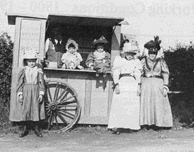Navvies were the men who actually built railways. The building of rail lines was very labour intensive. At one stage during the C19th, one in every 100 persons who worked in this country was a navvy. The word “navvy” came from the word navigator. By the mid-C19th – the height of railway mania – there were 250,000 navvies throughout the country. As railways were a vital component of the Industrial Revolution, the work of the navvies can also be considered crucial.
The bulk of railway building had to be done by hand. The thousands of miles of rail lines that were laid by the navvies was done without the use of machinery. The standard tools of the navies were picks, shovels and a wheelbarrow.
They lived by the rail line that they were building in so-called shanty towns. Huts could accommodate 20 men and they paid one and a half pennies for a bed for the night. Those who slept on the floor paid a lot less. Five nights of floor sleeping cost one penny.
The work of the navvies was very hard physical labouring. They had to eat well because their type of work required a decent meal at least once a day. A good navvy could shift 20 tonnes of earth a day. Navvies new to the job could not manage to keep up with the experienced workers and they frequently managed a half-day’s work only. Time was needed for them to gain the strength and stamina required.
By the standards of the time, navvies were well paid. They could earn 25 pence a day which compared well to those who worked in factories. However, their pay could take some time to arrive and many railways paid their navvies right next to a tavern – owned by the railway company!
The drinking of the navvies was well known and many towns feared the arrival of the navvies to their region. Navvies worked hard and they drank hard. “Going on a randy” was navvy slang for going on a drinking spree that could last several days. Work on the rail line stopped and people in towns could fear for their safety. Only tavern owners were happy about the high spending on alcohol.

If the navvies would not go to church, a church came to them
Why did the navvies live such a lifestyle ? Many navvies chose to live for the day. Death while working was high. Those working in tunnels that were being built were especially vulnerable to collapses and explosions. All work was done in a hurry and safety procedures were minimal. Getting the job done was far more important than employee safety especially as there were plenty of navvies. The widow of a dead navvy might get £5 compensation if she was lucky.
However, British navvies had a good reputation. Many went on to work in Europe where their hard work was rewarded – British navvies frequently got paid twice as much as anybody else working on the rail lines simply because they worked twice as hard as anybody else.